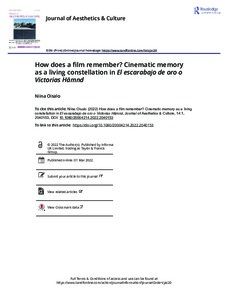How does a film remember? Cinematic memory as a living constellation in El escarabajo de oro o Victorias Hämnd
Oisalo Niina
https://urn.fi/URN:NBN:fi-fe2022081154967
Tiivistelmä
he film El escarabajo de oro o Victorias Hämnd (2014), directed by the Argentinean-Swedish duo Alejo Moguillansky and Fia-Stina Sandlund, presents clashing storylines, histories, merged film genres and conflicting aspirations within a transnational film production set in Argentina. It stages a performance founded on real circumstances, where two filmmakers (Moguillansky and Sandlund) begin working on a biopic based on the life of Victoria Benedictsson, a 19th-century Swedish feminist writer, but then, partly in secrecy, the main character changes to her contemporary, Leandro N. Alem, an Argentinean revolutionary politician, while all gets tangled up in a fictional story of a treasure hunt. The film crosses boundaries between documentary and fiction with its maze of rogues, tricksters, and unreliable narrators, opening up stories within stories. In the performance of the documentary filmmaking process, there is a constant struggle over memory: whose (hi)story gets to be told and from what angle.
In this article, cinematic memory in El escarabajo de oro o Victorias Hämnd is delineated through the performative gestures of reenactment and voice-over narration as aesthetic strategies that promote a non-linear, multidirectional perception of remembering. I suggest that the film offers an alternative way to approach cinematic memory, not attaching the act of remembering to an individual, a group or a nation, but to the film form itself. The film engenders cinematic memory as a living constellation, where diverse historical temporalities exist simultaneously and interact freely. In the film, cinematic memory is constantly being created and recreated in the here and now.
Kokoelmat
- Rinnakkaistallenteet [19206]
